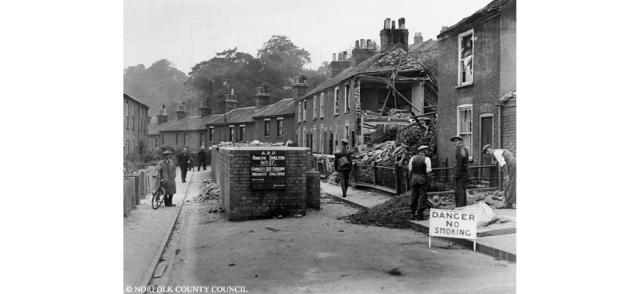On the night of 26 – 27 June 1942, St Mark’s Primary and Infants’ School on Hall Road, Norwich was bombed and destroyed during a Second World War air raid. The school’s temporary log book (NRO, N/ED 1/86), written by Head Teacher Amy Buckley, covers the month following the bombing, to its closure in July of the same year.
Amy Buckley started work at St Marks in 1924 and was working on some school records on the night of the air raid. She clearly lived close to the school as she ‘ran through the church yard just before the “all clear” to see whether the school was safe, and found it a blazing inferno – nothing to be done.’
The school re-opened two days after the fire on 29 June 1942, in a building used as the church hall and a Women’s Voluntary Service clothing store. Children were asked to come equipped with a pencil and a story book and accommodation was limited as the children were seated on long forms and Sunday School chairs. To ease the problems 40 older children transferred early to secondary schools: Lakenham Senior Girls and St Marks Senior Boys School. These neighbouring schools also lent furniture, books, paper, pencils and crayons so that lessons could go ahead, with three classes: 3rd years, 7+-9+ in class 2 and infants.
On 02 July ‘classes began serious work on a temporary timetable’.
9.00 – 9.40 Prayers and Scripture
9.45 – 10.45 Arithmetic / Physical training / Singing
10.45 – 11.00 Milk
11.00 – 11.45 Recreation
11.45 – 12.00 English
2.00 – 3.00 Handicraft (of some simple form)
3.00 – 3.30 Milk and recreation
3.30 – 4.00 Story or singing
On 15 July the logbook records that the school was closed for ‘ordinary work’ due to the ‘annual Diocesan Inspection’ and the 40 4th year pupils returned to take part, suggesting that the inspection may have been to check on learning and progress. There is no mention of the outcome.
As well as being cramped, the temporary school accommodation was not weatherproof as Buckley reports on 17 July that ‘the weather has been very wet … and it has been difficult to find dry places … since the roof was damaged by shrapnel in the air raid.’

Example of bomb damage in Norwich. Image courtesy of Picture Norfolk.
The entry for 24 July also provides an interesting insight into how new records were created after existing ones were destroyed. The first comment is about weighing and measuring all the children and making new medical cards, followed by the news that the Vicar has told her that the school’s managers can’t ‘recondition this old building’ and therefore the school will have to close. Most children were transferred to Lakenham Council Primary and Infants and one teacher went to work there as well. In relaying this information to the children’s families Buckley maintains the objective nature of a log book, recording on 29 July that ‘notices were delivered to the children, together with a personal message from the Head Teacher (herself) to each parent.’ It is only at the very end of the document that there is any display of emotion when Buckley mildly says ‘It is a strange end to the service of nearly 18 years in this school.’
Researched and compiled by Alex Atherton, NRO Research Blogger














That’s how it was during the war every one done whatever they had to continue with life
LikeLike
Thanks for the comment, Colin. We hope you enjoyed the blog post.
LikeLike